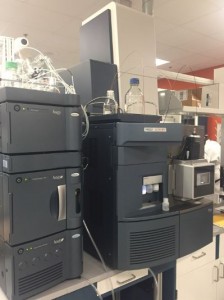Our team at Poly mer Solutions Incorporated (PSI) decided to make a major investment in our analytical capabilities by acquiring and installing a liquid chromatography-mass spectrometry (LC-MS) system, specifically a Waters Xevo G2-XS QTof. There are many different types of LC-MS instruments available, and not all LC-MS instruments are well suited to every type of analysis. Choosing the right instrument for the task at hand is of critical importance.
mer Solutions Incorporated (PSI) decided to make a major investment in our analytical capabilities by acquiring and installing a liquid chromatography-mass spectrometry (LC-MS) system, specifically a Waters Xevo G2-XS QTof. There are many different types of LC-MS instruments available, and not all LC-MS instruments are well suited to every type of analysis. Choosing the right instrument for the task at hand is of critical importance.
LC-MS applications can be classified as qualitative or quantitative. Qualitative analysis involves the separation and identification of unknown components present in often complex sample mixtures. Quantitative analysis measures concentrations of specific, known chemical compounds. Many laboratories purchase an LC-MS with a single, very specific application in mind. Since our company is an independent testing lab, often referred to as a contract analytical laboratory, we needed an instrument that is both qualitative and quantitative, and versatile to the wide range of testing needs of our clients.
The tandem quadrupole (also known as triple quadrupole) is arguable the most popular type of LC-MS instrument, and is the gold standard for quantitative analysis due to its outstanding sensitivity in MS/MS mode. A tandem quadrupole employs two quadrupole mass analyzers in series with a collision cell separating the two mass analyzers. Analysis in MS/MS mode works by isolating a precursor ion in the first quadrupole, fragmenting the precursor ion in the collision cell, and then selectively analyzing for one or more known fragment ions using the final quadrupole. The sets of MS/MS precursor and product ions must be defined and the collision energy used for fragmentation must be optimized a priori for each known target compound, which means that the highly sensitive MS/MS analysis of a tandem quadrupole is limited to known chemical compounds for which reference standards can be obtained and run on the instrument before samples are analyzed.
PSI does perform quantitative analysis of known target compounds, but we also perform a significant amount of screening and identification of unknown compounds. Extractables and leachables studies and competitor product analysis (deformulation) are examples of qualitative analysis where unknowns present in a sample must be identified. A tandem quadrupole LC-MS is of very limited use for identification of unknown compounds because it produces mass spectra that are unit mass resolution. In recent years, time-of-flight (TOF) mass spectrometers have become popular for identification of unknowns due to their ability to generate high resolution-accurate mass (HRAM) mass spectral data. The molecular formula of an unknown compound can be predicted from the HRAM data, and the molecular formula can then be searched against databases containing information on millions of known chemical compounds. The database search yields a list of candidate chemical structures, and then software is used to predict the fragmentation pattern of each candidate structure and compare it to the observed fragmentation in the mass spectral data, to find the best match to the unknown sample compound. This type of unknown identification is not possible with a tandem quadrupole because the unit mass resolution mass spectral data cannot predict the molecular formula with sufficient accuracy.
TOF mass spectrometers have traditionally been used for qualitative analysis, because a limited dynamic range has hindered their usefulness for quantitation. Additionally, their sensitivity has lagged behind that of a tandem quadrupole operating in MS/MS mode. Dynamic range is defined as the difference between the highest and lowest concentrations of a target compound that can be measured in the same analysis. TOF instrument manufacturers have significantly improved in recent years the dynamic range of their instruments and have also dramatically improved the sensitivity. Additional improvements in sensitivity for quantitative analysis are achieved by placing a quadrupole mass analyzer and collision cell in front of the time-of-flight analyzer, resulting in a hybrid instrument known as a Q-TOF. This allows one to perform highly sensitive MS/MS analysis for known target compounds, as well as being able to perform full-scan HRAM screening for unknowns, giving the Q-TOF best of both worlds capability.
There are several vendors offering TOF and Q-TOF LC-MS instrumentation, as well as one vendor offering an alternative and increasingly popular type of HRAM mass spectrometer known as the Orbitrap. The design and performance of the hardware is very important in terms of being able to generate high quality data. However, the task of processing LC-MS data and distilling it down into useful information can be a daunting and time consuming endeavor. Software that facilitates and automates the data analysis is of critical importance. Waters Corporation has developed its UNIFI software, which contains built-in workflows that facilitate both quantitative and qualitative data analysis. IN addition to being a data system, the UNIFI software enables secure data handling and storage, satisfying regulatory expectations for data integrity. Other software options were more piecemeal, requiring the use of different programs for different types of data analysis.
